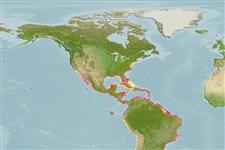>
Eupercaria/misc (Various families in series Eupercaria) >
Gerreidae (Mojarras)
Etymology: Eucinostomus: Greek, eu = good + Greek, kyon = dog + Greek, stoma = mouth (Ref. 45335).
More on authors: Baird & Girard.
Environment: milieu / climate zone / depth range / distribution range
Ökologie
seewasser; süßwasser; brackwasser riff-verbunden; tiefenbereich 0 - 12 m (Ref. 5227). Subtropical; 41°N - 30°S, 120°W - 34°W
Eastern Pacific: Anaheim Bay in southern California, USA southward to Peru, including the Galapagos Islands. Western Atlantic: New Jersey, USA and Bermuda through the Gulf of Mexico and the Caribbean to southeastern Brazil (Ref. 7251).
Length at first maturity / Size / Gewicht / Alter
Maturity: Lm 12.8 range ? - ? cm
Max length : 21.2 cm TL Männchen/unbestimmt; (Ref. 102462); common length : 15.0 cm TL Männchen/unbestimmt; (Ref. 3722); max. veröff. Gewicht: 119.66 g (Ref. 102462)
Rückenflossenstacheln (insgesamt): 9; Rückenflossenweichstrahlen (insgesamt): 10; Afterflossenstacheln 3; Afterflossenweichstrahlen: 8. Tip of dorsal fin dusky. Premaxillary groove continuous but narrow, bordered by scales anteriorly (Ref. 26938).
Found over soft bottoms of bays and shallow inshore areas, often along sand beaches (Ref. 2850). Enters freshwater (Ref. 7251). Juveniles are encountered in lagoons of mangroves. Omnivorous (Ref. 9303). Marketed fresh but not highly esteemed; processed into fish meal and used as live bait in the snapper fishery (Ref. 3722).
Life cycle and mating behavior
Geschlechtsreife | Fortpflanzung | Ablaichen | Eier | Fecundity | Larven
Eschmeyer, W.N., E.S. Herald and H. Hammann, 1983. A field guide to Pacific coast fishes of North America. Boston (MA, USA): Houghton Mifflin Company. xii+336 p. (Ref. 2850)
IUCN Rote Liste Status (Ref. 130435)
Bedrohung für Menschen
Harmless
Nutzung durch Menschen
Fischereien: weniger kommerziell; Köder: occasionally
Mehr Information
ReferenzenAquakulturAquakultur ProfilZuchtlinienGenetikElectrophoresesVererbbarkeitKrankheitenVerarbeitungNutrientsMass conversion
PartnerBilderStamps, Coins Misc.LauteCiguateraGeschwindigkeitSchwimmstilKiemenoberflächeOtolithsGehirngrößeSehfähigkeit
Tools
Zusatzinformationen
Download XML
Internet Quellen
Estimates based on models
Preferred temperature (Ref.
123201): 20.6 - 28.3, mean 27 °C (based on 1053 cells).
Phylogenetic diversity index (Ref.
82804): PD
50 = 0.5010 [Uniqueness, from 0.5 = low to 2.0 = high].
Bayesian length-weight: a=0.00977 (0.00825 - 0.01157), b=3.08 (3.04 - 3.12), in cm total length, based on LWR estimates for this species (Ref.
93245).
Trophic level (Ref.
69278): 3.2 ±0.1 se; based on diet studies.
Widerstandsfähigkeit (Ref.
120179): hoch, Verdopplung der Population dauert weniger als 15 Monate. (Preliminary K or Fecundity.).
Fishing Vulnerability (Ref.
59153): Low to moderate vulnerability (25 of 100).
Nutrients (Ref.
124155): Calcium = 51.4 [19.0, 111.5] mg/100g; Iron = 0.642 [0.289, 1.253] mg/100g; Protein = 20.1 [18.1, 22.1] %; Omega3 = 0.216 [0.105, 0.433] g/100g; Selenium = 9.44 [4.21, 20.40] μg/100g; VitaminA = 54.2 [13.4, 206.5] μg/100g; Zinc = 1.2 [0.7, 1.9] mg/100g (wet weight);
